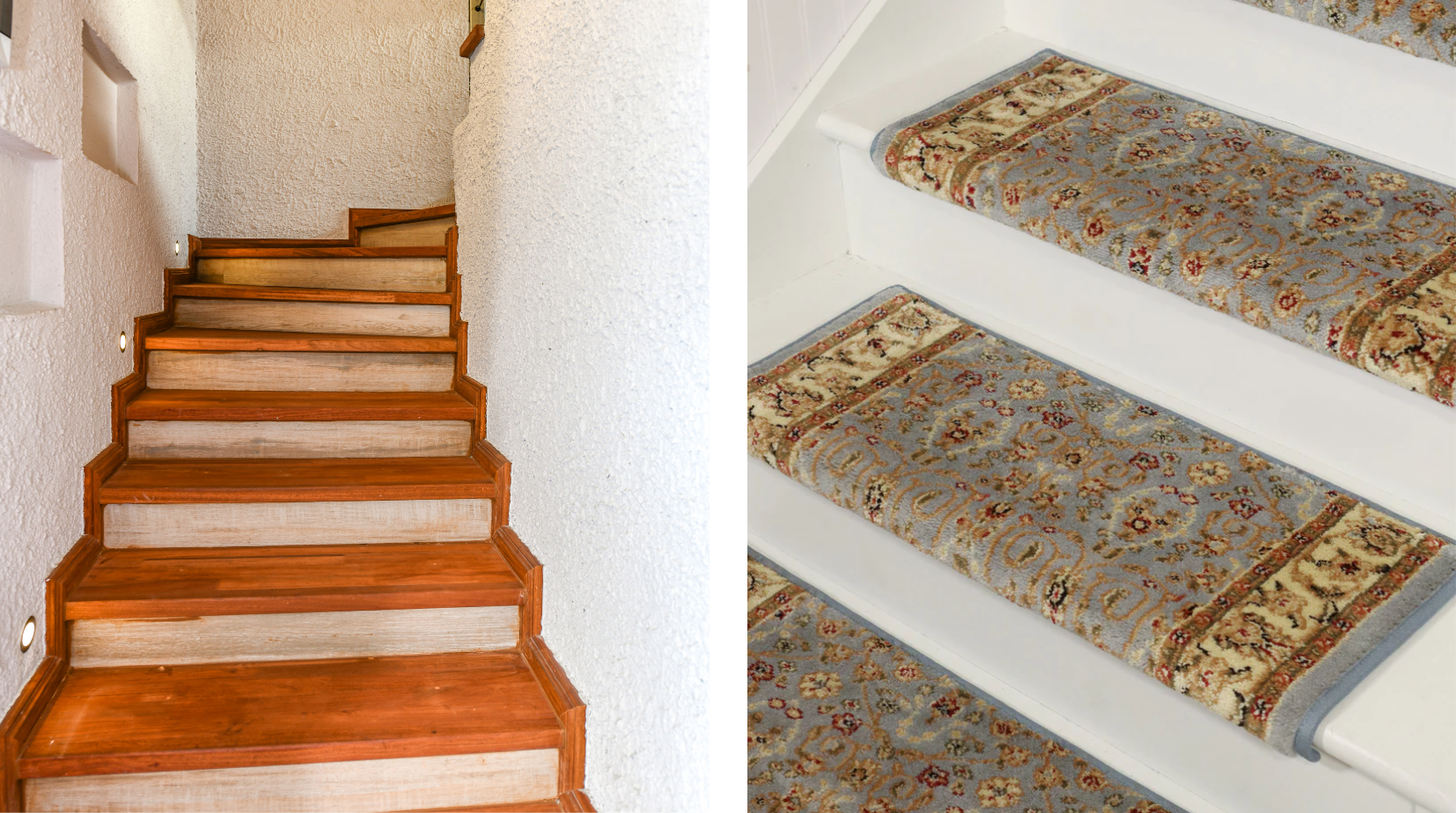Tired of looking at worn-out steps or tripping over loose stair coverings?
The best way to tackle how to remove carpet stair treads is to gently lift the edges with a putty knife or pliers, then slowly pull up the treads while removing any staples, tack strips, or adhesive.
This method protects your stairs while giving you a clean surface to work with.
Whether your carpet stair treads are peel-and-stick, stapled, or attached with tack strips, each removal method requires a specific approach.
In this guide, you’ll get clear, step-by-step instructions to handle each type safely.
By the end, you'll be ready to update your staircase with confidence.
Why Remove Carpet Stair Treads?
Over time, carpet stair treads take a beating.
High traffic, pets, kids, dirt, and daily wear can cause them to fray, flatten, or stain.
Even if your carpet is still intact, outdated patterns or colors can make your entire home feel older than it is.
Removing old treads is the first move if you're:
-
Updating to a wood or rubber tread
-
Refinishing stairs for resale value
-
Making your staircase safer for children or aging family
-
Giving your space a clean, modern refresh
The best part? This is absolutely a DIY project you can do in a weekend.
What You’ll Need: Tools and Safety Gear
Before we dig into removal instructions, make sure you have everything on hand to do the job safely and cleanly.
Basic Tools
-
Putty knife (for lifting edges)
-
Pry bar or flathead screwdriver
-
Needle-nose pliers
-
Staple remover
-
Hammer (for any nails or tack strips)
-
Utility knife (optional for cutting up carpet)
Safety Gear
-
Safety goggles
-
Work gloves
-
Dust mask (especially if removing older treads)
-
Knee pads (optional, but your body will thank you)
Cleanup Tools
-
Trash bags
-
Adhesive remover (for stubborn glue)
-
Vacuum or shop vac
-
Wood filler (for patching holes if needed)
Once you're prepped, it's time to tackle the job.
How to Remove Peel and Stick Carpet Stair Treads
Peel and stick stair treads are one of the easiest types to remove—when done carefully.
Step 1: Prep Your Space
Clear the staircase of furniture, decorations, or any nearby rugs.
Ensure the area is well-lit and ventilated.
Step 2: Start Lifting Edges
Using a putty knife, gently slide under the corner of one tread.
Wiggle it just enough to create a lift without gouging the stair underneath.
Step 3: Peel Slowly
Grasp the edge and slowly peel the tread up.
Pull at a low angle to minimize resistance.
If the adhesive fights back, use a heat gun or hair dryer to soften the glue.
Step 4: Clean the Surface
Once the tread is removed, wipe down the stair with an adhesive remover.
Use a cloth or scraper to lift any sticky residue.
This step is essential for prepping your stairs for new treads or paint.
If you’ve ever wondered how to remove rubber stair treads, the process is nearly identical to peel and stick.
Rubber versions often use similar adhesives and come up the same way.
Just be sure to check for stronger glue, especially on commercial staircases.
How to Remove Tack Strip Carpet Stair Treads
Tack strip-installed carpet is more secure and may require a bit more patience—but it’s totally doable for DIYers.
Step 1: Safety First
Put on gloves and goggles to protect from nails and flying debris.
Clear the work zone.
Step 2: Break the Bond
Slide a pry bar or flathead screwdriver under the edge of the tread.
Tap lightly with a hammer to wedge it under the carpet.
Step 3: Work in Sections
Lift the carpet gently to expose the tack strip.
Then carefully pry up the tack strip, starting at one end and working your way across.
Step 4: Remove Nails and Fill Holes
Use pliers to pull up any nails or staples.
If the wood beneath is damaged, fill the holes with wood filler and let it dry.
Homeowners often ask how do you remove stair treads without damaging them—especially if the plan is to reuse the wood underneath.
The key is to go slow, keep your tools flat against the surface, and never yank upward.
Instead, work in angles and lift gently.
Wood stairs are resilient, but rushing can leave behind gouges or splinters.
How to Remove Stapled Carpet Stair Treads
Stapled treads are the most common in older homes.
While effective, they can be tough to pull out cleanly without the right technique.
Step 1: Locate All Staples
Use your fingers or pliers to locate where the staples are holding the carpet down.
Often they’re along the edges and corners.
Step 2: Loosen and Remove
Work with a staple remover or needle-nose pliers.
Wiggle the tool under the staple, then gently pry it up.
Step 3: Remove the Tread
Once most of the staples are removed, lift the tread slowly.
If it sticks, check for any remaining staples you may have missed.
Step 4: Clean the Surface
Use a vacuum to pick up debris and loose fibers.
If needed, sand down any rough areas or patch small holes with filler.
What to Expect Underneath
Once your treads are removed, you may be surprised at what you find.
Depending on the age and installation method, the wood might be in great shape—or need a bit of love.
Here’s what to look for:
-
Glue Residue: Use adhesive remover and a scraper
-
Tack Strip Holes: Fill with wood filler, sand smooth
-
Stains or Discoloration: A sanding block or orbital sander can help prep for refinishing
-
Splinters or Nails: Remove and patch as needed
Cleaning and prepping your stairs post-removal is just as important as the removal itself.
This helps ensure any new treads will adhere properly and last longer.
How Long Does It Take?
For a standard staircase with 12–14 steps:
-
Peel and Stick: 30–60 minutes
-
Tack Strip: 1.5–2 hours
-
Stapled: 1–2 hours
It all depends on how carefully you work and the condition of the treads.
When to Call a Pro
If you're dealing with damaged stairs, excessive glue, or an unfamiliar installation method, it’s okay to get help.
A local contractor or flooring specialist can save you time and headache—especially if you’re on a tight renovation timeline.
That said, most Oak Valley Designs customers tackle this project themselves and are proud of the results.
It’s empowering to transform your own space, one step at a time.
What Comes After Removal?
Once the old carpet treads are gone, you’ve got a blank canvas.
From here, you can:
-
Install DIY-friendly stair treads in custom colors or sizes
-
Stain or paint the wood
-
Add rubber stair treads for better grip and durability
-
Apply decorative runners or landings
If you’re switching from carpet to wood or rubber, just be sure the surface is flat, clean, and free of leftover staples or glue.
Steps to Success
Removing your carpet stair treads is more than a home project—it’s a smart, confidence-boosting upgrade.
By following the steps above, you’ll save money, improve safety, and bring a cleaner, more custom look to your staircase.
Whether you’re refreshing your entryway or preparing your home for resale, the details matter.
Ready to take the next step?
Our family-run team at Oak Valley Designs would love to help you find the perfect stair tread replacement—with comfort, style, and safety in mind.
Start Your Stair Upgrade Today
-
Website: https://oakvalleydesigns.com/
-
Phone: 706.331.0315
-
Email: info@oakvalleydesigns.com
-
Address: 30 River Ct SW Bldg E Cartersville, Ga 30120




